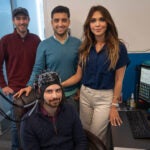The URI Department of Electrical, Computer, and Biomedical Engineering offers a dynamic, multidisciplinary environment. Our programs develop expertise in Electrical Engineering (power systems, electronics, renewable energy, robotics), Computer Engineering (hardware, software, AI, cybersecurity, high-performance computing), and Biomedical Engineering (medical devices, biosensors, wearable technology), preparing students for technological innovation. Our faculty conduct pioneering research in fields such as AI, robotics, cyber-physical systems security, integrated circuit design, power electronics, wearable biosensing, brain-computer interfaces, and neural robotics. Students gain hands-on experience in state-of-the-art labs.
Our department has a rich history of innovation, having established the first NSF Robotics Research Center and introduced the nation’s first microprocessor courses. We continue to lead the way by integrating AI and ML into our curriculum. Students will take rigorous capstone projects with industrial advisors and benefit from our unique programs, such as the International Engineering Program, Accelerated B.S./M.S. Program, and minors in robotics, cybersecurity, and entrepreneurship.
Recent News
 Biomedical engineering professor awarded NSF grant to study Parkinson’s using virtual reality - University of Rhode Island biomedical engineering associate professor Yalda Shahriari has been awarded a three-year grant from the National Science Foundation to research hallucinations related to Parkinson’s disease using VR.
Biomedical engineering professor awarded NSF grant to study Parkinson’s using virtual reality - University of Rhode Island biomedical engineering associate professor Yalda Shahriari has been awarded a three-year grant from the National Science Foundation to research hallucinations related to Parkinson’s disease using VR. Biomedical researchers head international team exploring wearable technology to help stroke survivors - The three-year project backed by a $500K grant from National Science Foundation.
Biomedical researchers head international team exploring wearable technology to help stroke survivors - The three-year project backed by a $500K grant from National Science Foundation. Office of Naval Research awards $4.7M for cyber-physical security and resilience - Four University of Rhode Island engineering professors have been awarded a $4.7 million grant from the Office of Naval Research to advance the security and resilience of AI-enabled power grids, promote workforce development, and secure manufacturing environments.
Office of Naval Research awards $4.7M for cyber-physical security and resilience - Four University of Rhode Island engineering professors have been awarded a $4.7 million grant from the Office of Naval Research to advance the security and resilience of AI-enabled power grids, promote workforce development, and secure manufacturing environments.



